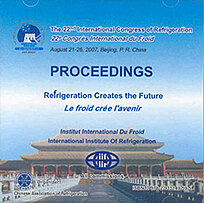
Summary
A two-stage heat transformer is superior to a single-stage one because it has higher efficiency or temperature lift. This paper carries out a systematic study on two-stage chloride heat transformers. On the basis of chlorides selection, four kinds of commonly used cycles, the resorption cycle (3S/G), double-effect resorption cycle (3S/G), two internal heat recovery resorption cycles (3S/G and 4S/G) are analyzed and compared according to the COP, exergy efficiency, temperature lift and some operational parameters. Among these four cycles, the resorption one (3S/G) is proved to be the best for driven heat temperature no more than 100°C. The double-effect resorption cycle (3S/G) has the highest COP, but lowest temperature lift. The two internal heat recovery resorption cycles (3S/G and 4S/G) have similar operating principles, but the 3S/G one is found to be the best at the driven heat temperature of 120°C because its system pressure is smaller.
Available documents
Format PDF
Pages: ICR07-E2-1058
Available
Public price
20 €
Member price*
Free
* Best rate depending on membership category (see the detailed benefits of individual and corporate memberships).
Details
- Original title: Thermodynamic analysis and comparison of two-stage chloride heat transformers.
- Record ID : 2007-2595
- Languages: English
- Source: ICR 2007. Refrigeration Creates the Future. Proceedings of the 22nd IIR International Congress of Refrigeration.
- Publication date: 2007/08/21
Links
See other articles from the proceedings (839)
See the conference proceedings
Indexing
-
Conceptual design of novel multi-stage solid-ga...
- Author(s) : WANG C., ZHANG P., YU Y. Q., et al.
- Date : 2007/08/21
- Languages : English
- Source: ICR 2007. Refrigeration Creates the Future. Proceedings of the 22nd IIR International Congress of Refrigeration.
- Formats : PDF
View record
-
Performance study of a new compression/absorpti...
- Author(s) : PARK S. R., TIAN H.
- Date : 2005/08/30
- Languages : English
- Source: Commercial Refrigeration. Thermophysical Properties and Transfer Processes of Refrigerants. Proceedings of the IIR International Conferences.
- Formats : PDF
View record
-
Water-ammonia two-stage compressor thermotransf...
- Author(s) : MOROSUK T., MOROSUK L., DIASSANA B., TCHAIKOVSKY V.
- Date : 1998/06/02
- Languages : English
- Source: Natural working fluids '98. IIR-Gustav Lorentzen Conference.
- Formats : PDF
View record
-
THE APPLICATION OF STAGED PROCESSES IN THE CYCL...
- Author(s) : BYKOV A. V.
- Date : 1982/05/26
- Languages : English
- Formats : PDF
View record
-
A NEW CYCLE FOR ENERGY SAVING OF LITHIUM BROMID...
- Author(s) : MAO Y. H., CHENG Y. X.
- Date : 1987/08/24
- Languages : English
- Source: Development in refrigeration, refrigeration for development. Proceedings of the XVIIth international Congress of Refrigeration.
- Formats : PDF
View record
